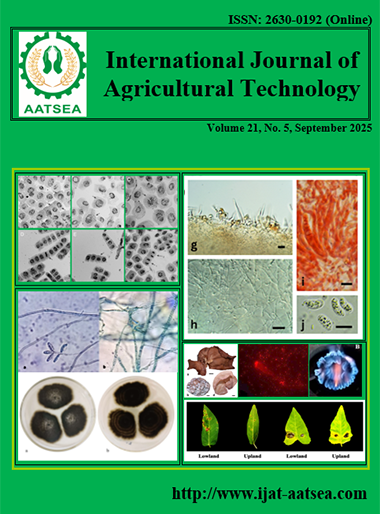Effects of vermicompost on growth and yield of Japonica rice (Koshihikari Var.) in Thailand.
Main Article Content
Abstract
Significant differences were observed in plant height, number of tillers, and chlorophyll content. The 10% vermicompost treatment resulted in the tallest plants at 88 days. The combined vermicompost and chemical fertilizer treatment (T8) produced the highest number of tillers, though it did not differ significantly from the 20% vermicompost treatment (T4). Over time, vermicompost-amended treatments outperformed chemical fertilizer alone in most growth and yield parameters. Treatment 5 yielded the highest total seed count, while T4 resulted in the healthiest seeds and the greatest total fresh and dry seed weights. T4 also had the widest, longest, and thickest seeds, with a fivefold increase in total dry seed weight compared to the control. These findings strongly supported the application of vermicompost particularly at 10–30% for improved Japonica rice growth and yield, highlighting its potential for organic production systems.
Article Details

This work is licensed under a Creative Commons Attribution-NonCommercial-NoDerivatives 4.0 International License.
References
Atiyeh, R. M., Subler, S., Edwards, C. A., Bachman, G., Metzger, J. D. and Shuster, W. (2000). Effects of vermicomposts and composts on plant growth in horticultural container media and soil. Pedo biologia, 44:579-590.
Benchamaporn, W., Sukprasert, S., Boonyalug, S., Pantong, P. and Suksumek, P. (2021). Good practices on biodiversity conservation and utilization in rice farming. Publishing of Suetawan, Bangkok, Thailand, p.6
Chuleemas, B. I. and Ajcharawadee K. (2017). Using vermitechnology in soil rehabilitation for rice production in salt-affected areas of Northeast Thailand. International Journal of Environmental and Rural Development, 8:16-21.
Chamani, E., Joyce, D. C. and Reihanytabar, A. (2008). Vermicompost effects on the growth and flowering of Petunia hybrida ‘Dream Neon Rose’. American-Eurasian Journal of Agricultural & Environmental Sciences, 3:506-512.
Duwayri. M., Tran. D. V. and Ng. V. N. (2024). reflections on yield gaps in rice production: how to narrow the gaps. Retrieved from https://www.fao.org/4/x6905e/x6905e05.htm
Edwards, C. A. (2004) Earthworm Ecology. 2nd ed. CRC Press.
Edwards, C. A., Arancon, N. Q. (2004). Vermicomposts suppress plant pest and disease attacks. Biocycle, 45:51-55.
Ghosh. M., Chattopadhyay. G. N., Chakravarti, P. P. and Bural, K. (1996). Study on use of vermicompost in integrated plant nutrient management. A paperpresented in national seminar on developments in soil science held at Anand, Gujarat, Oct., 28 - Nov. 1, 1996.
International Rice Research Institute (2024). RiceToday. Retrieved from https://ricetoday.irri.org/
Iqbal, M., Ali, S., Rizwan, M. and Riaz, M. (2024). Vermicompost supply enhances fragrant-rice yield and reduces cadmium uptake under contaminated soil conditions. Microorganisms, 12:1252.
Jadhav, A. D. (1996). Effect of FYM and vermicompost on the yield of rice (Oryza sativa Linn.) and Physiochemical properties of lateritic soil of KonKan. (Master Thesis) K.K.V., Dapoli.
Jianwitchayakul, P. and Somniyam, P. (2021). Efficiency of vermicompost from water hyacinth on growth, yield and yield component of rice var. RD41. Agriculture Journal suppl, 1: 949-955.
Jourdain D., Srisopaporn, S., Perret, S. and Shivakoti, G. (2017). The role of information irovision on public gap standard adoption: the case of rice farmers in the central plains of Thailand. In Ganesh P. S, Ujjwal P., and Helmi. Refinding diversity and dynamics of natural resources management in dynamic asia, 331-350.
Kumari, M. S. and Kumari, U. (2002). Effetc of vermicompost enriched with rockphosphate on growth and yield of cowpea (Vigna unguiculata L. Walp). Journal of Indian Society of Soil Science, 50:223-224.
Manaig, E. M. (2016). Vermicomposting efficiency and quality of vermicompost with different bedding materials and worm food sources as substrate. The Journal of Agriculture and Forestry Sciences, 4:1-13.
Mindalisma, S. C., Mauli, L.R., Siregar, D., Asbur, Y., Purwaningrum, Y. and Rambe, R. D. H. (2023). Application of vermicompost to increase growth and yield of upland rice (Oryza sativa L.) in marginal land. World Journal of Pharmaceutical and Life Sciences, 9:9607-9612.
Miyamoto, M. (2017). Influence of changing Thai Society on the Japanese restaurant industry in Bangkok. Journal of Humanities, 20:13-32.
Nabheerong. N., Hintang, P. and Poonyarit, M. (2005). Japonica rice yield trials in farmers’ field of the lower norther part of Thailand. Thai Agricultural Research Journal, 23:228-240.
Nakwilai P., Cheabuc, S., Narumona, P., Saensuk, C., Arikita, S. and Malumpong, C. (2020). Evaluation of japonica rice (Oryza sativa L.) varieties and their improvement in terms of stability, yield and cooking quality by pure-line selection in Thailand. ScienceAsia, 46:157-168.
Ruan, S., Wu, F., Lai, R., Tang, X., Luo, H. and He, L. (2021). Preliminary application of vermicompost in rice production: Effects of nursery raising with rermicompost on fragrant rice performances. Agronomy, 11:1253.
Subler, S., Edwards, C. A. and Metzger, J. (1998). Comparing vermicompost and composts: Effects on plant growth. BioCycle. 39:63-66.
Sushree, S. S. and Vikramreddy, M. (2009). Effects of kitchen-waste vermicompost on chlorophyll content' leaf area index, biomass and other growth characteristics of fenugreek (Trigonella foenum graceum linn.) under field conditions. Proceedings of the National Academy of Sciences, India Section B, 79:312-317.
Tak, S. (2003). Effect of vermicompost and foliar spray of Zinc on growth, yield and quality of Green Gram. (Master Thesis), Rajasthan Agricultural University, Bikaner.
Talashikar, S. C., and Dosani, K. A. A. (2008). Earthworms in Agriculture. AGROBIOS(INDIA), Hinglaj offset Printers.
Todawat, A., Sharma, S. R., Lakhran, H. and Hemraj (2017). Effect of vermicompost and zinc on growth, yield attributes and yield of Greengram [Vigna radiata (L.)] under semi-arid region of Rajasthan. International Journal of Current Microbiology and Applied Sciences, 6:175-180
Wonglom, P., Ruangwong, O., Poncheewin, W., Arikit, S., Riangwong, K. and Sunpapao, A. (2024). Trichoderma-Bioenriched vermicompost induces defense response and promotes plant growth in Thai rice variety “Chor Khing” Journal of Fungi, 10:582.
Yatoo, A. M., Ali, N., Baba, Z. A. and Hassan, B. (2021). Sustainable management of diseases and pests by vermicompost and vermicompost tea. Agronomy for Sustainable Development, 41:1-15.


